tow TOYOTA GT86 2017 Owners Manual (in English)
[x] Cancel search | Manufacturer: TOYOTA, Model Year: 2017, Model line: GT86, Model: TOYOTA GT86 2017Pages: 505, PDF Size: 9.9 MB
Page 1 of 505
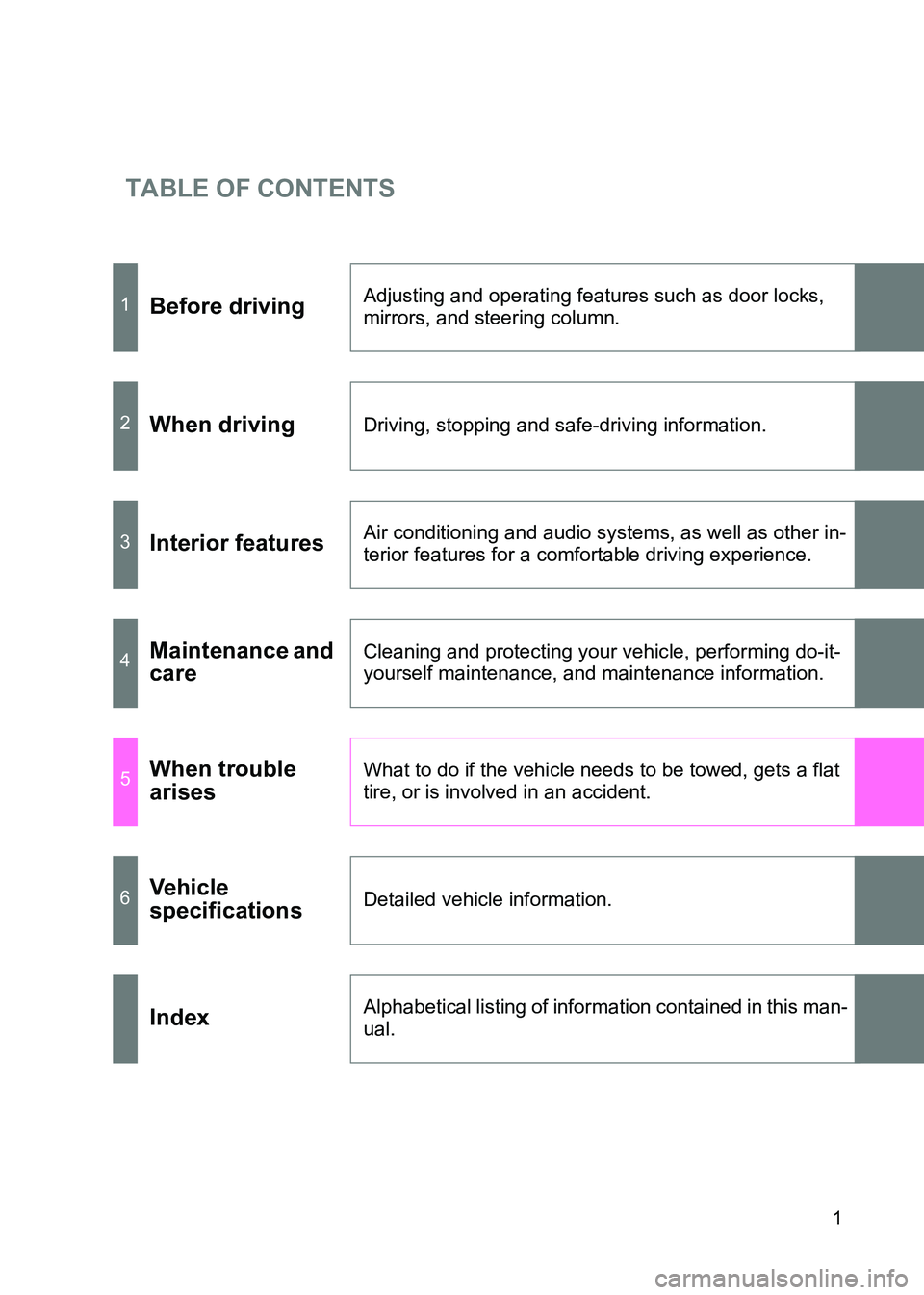
TABLE OF CONTENTS
86_EE (OM18071E)
1
1Before drivingAdjusting and operating features such as door locks,
mirrors, and steering column.
2When drivingDriving, stopping and safe-driving information.
3Interior featuresAir conditioning and audio systems, as well as other in-
terior features for a comfortable driving experience.
4Maintenance and
careCleaning and protecting your vehicle, performing do-it-
yourself maintenance, and maintenance information.
5When trouble
arisesWhat to do if the vehicle needs to be towed, gets a flat
tire, or is involved in an accident.
6Vehicle
specificationsDetailed vehicle information.
IndexAlphabetical listing of information contained in this man-
ual.
Page 3 of 505
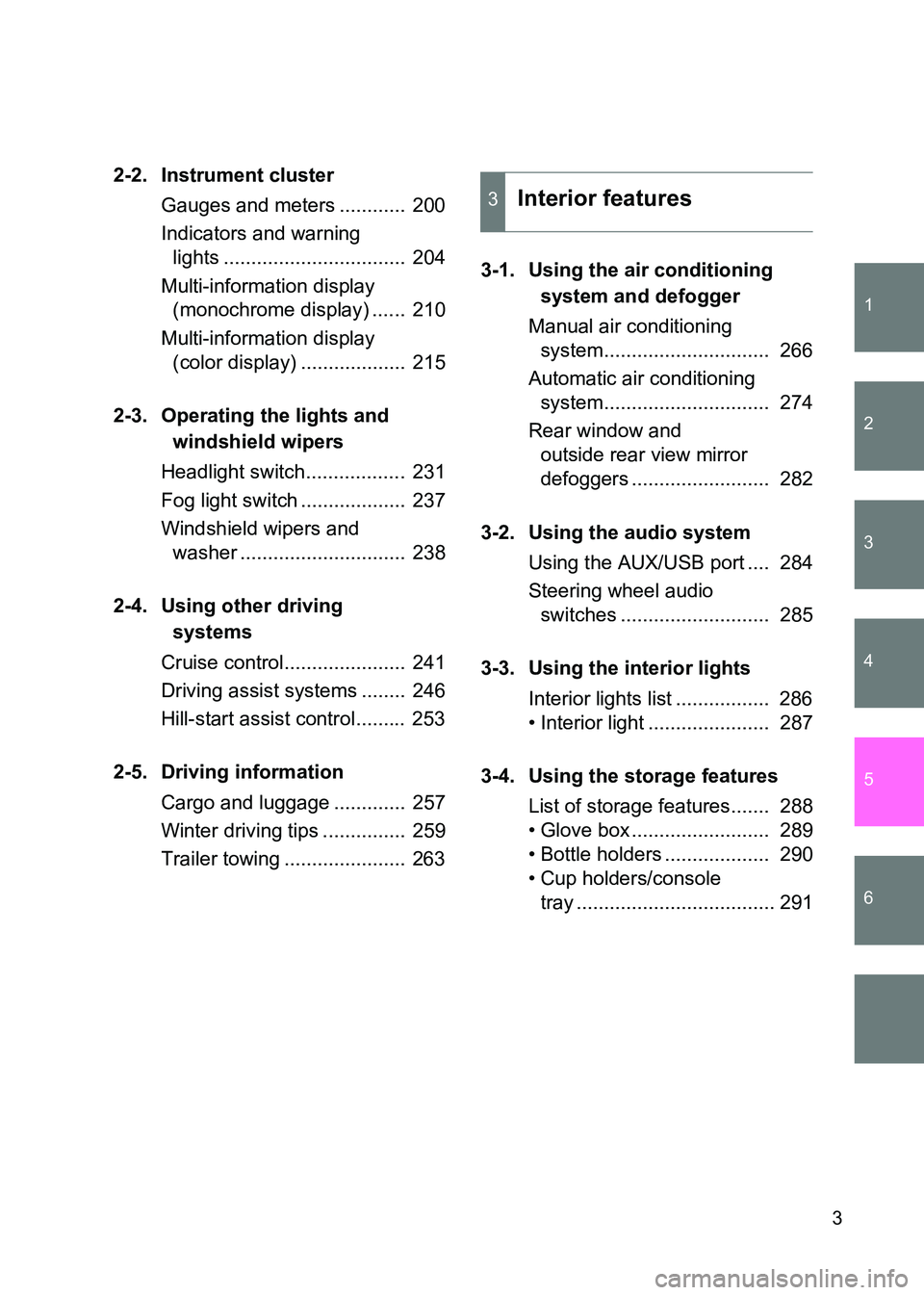
1
2
3
4
5
6
86_EE (OM18071E)
3
2-2. Instrument clusterGauges and meters ............ 200
Indicators and warning lights ................................. 204
Multi-information display (monochrome display) ...... 210
Multi-information display (color display) ................... 215
2-3. Operating the lights and windshield wipers
Headlight switch.................. 231
Fog light switch ................... 237
Windshield wipers and washer .............................. 238
2-4. Using other driving systems
Cruise control...................... 241
Driving assist systems ........ 246
Hill-start assist control......... 253
2-5. Driving information Cargo and luggage ............. 257
Winter driving tips ............... 259
Trailer towing ...................... 263 3-1. Using the air conditioning
system and defogger
Manual air conditioning system.............................. 266
Automatic air conditioning system.............................. 274
Rear window and outside rear view mirror
defoggers ......................... 282
3-2. Using the audio system Using the AUX/USB port .... 284
Steering wheel audio switches ........................... 285
3-3. Using the interior lights Interior lights list ................. 286
• Interior light ...................... 287
3-4. Using the storage features List of storage features....... 288
• Glove box ......................... 289
• Bottle holders ................... 290
• Cup holders/console tray .................................... 291
3Interior features
Page 4 of 505

TABLE OF CONTENTSIndex
86_EE (OM18071E)
4
3-5. Other interior featuresSun visors ........................... 293
Vanity mirrors...................... 294
Clock ................................... 295
Ashtray................................ 296
Power outlets ...................... 297
Seat heaters ....................... 299
Floor mat............................. 301
Trunk features..................... 304
4-1. Maintenance and care Cleaning and protecting the vehicle exterior ........... 308
Cleaning and protecting the vehicle interior ............ 312
Cleaning and protecting the Alcantara
® area .......... 316
4-2. Maintenance Maintenance requirements..................... 318 4-3. Do-it-yourself maintenance
Do-it-yourself service precautions ...................... 321
Hood................................... 324
Positioning a floor jack ....... 326
Engine compartment .......... 328
Tires ................................... 341
Tire inflation pressure......... 352
Wheels ............................... 354
Air conditioning filter ........... 357
Wireless remote control/electronic
key battery ....................... 360
Checking and replacing fuses ................................ 364
Light bulbs .......................... 372
5-1. Essential information Emergency flashers ........... 384
If your vehicle needs to be towed ...................... 385
If you think something is wrong ............................... 393
Fuel pump shut off system.............................. 394
4Maintenance and care
5When trouble arises
Page 41 of 505

41
1-2. Opening, closing and locking the doors and trunk
1
Before driving
86_EE (OM18071E)
■
Conditions affecting operation
The smart entry & start system uses weak radio waves. In the following situ-
ations, the communication between the electronic key and the vehicle may
be affected, preventing the smart entry & start system, wireless remote con-
trol and engine immobilizer system from operating properly.
(Way of coping →P. 455)
● When the electronic key battery is depleted
● Near a TV tower, electric power plant, gas station, radio station, large dis-
play, airport or other facility that generates strong radio waves or electri-
cal noise
● When the electronic key is in contact with, or is covered by the following
metallic objects
• Cards to which aluminum foil is attached
• Cigarette boxes that have aluminum foil inside
• Metallic wallets or bags
• Coins
• Hand warmers made of metal
• Media such as CDs and DVDs
● When other wireless key (that emit radio waves) is being used nearby
● When carrying the electronic key together with the following devices that
emit radio waves
• A portable radio, cellular phone, cordless phone or other wireless com-
munication device
• Another vehicle's electronic key or a wireless key that emits radio waves
• Personal computers or personal digital assistants (PDAs)
• Digital audio players
• Portable game systems
● If window tint with a metallic content or metallic objects are attached to
the rear window
● When the electronic key is placed near a battery charger or electronic
devices
Page 54 of 505
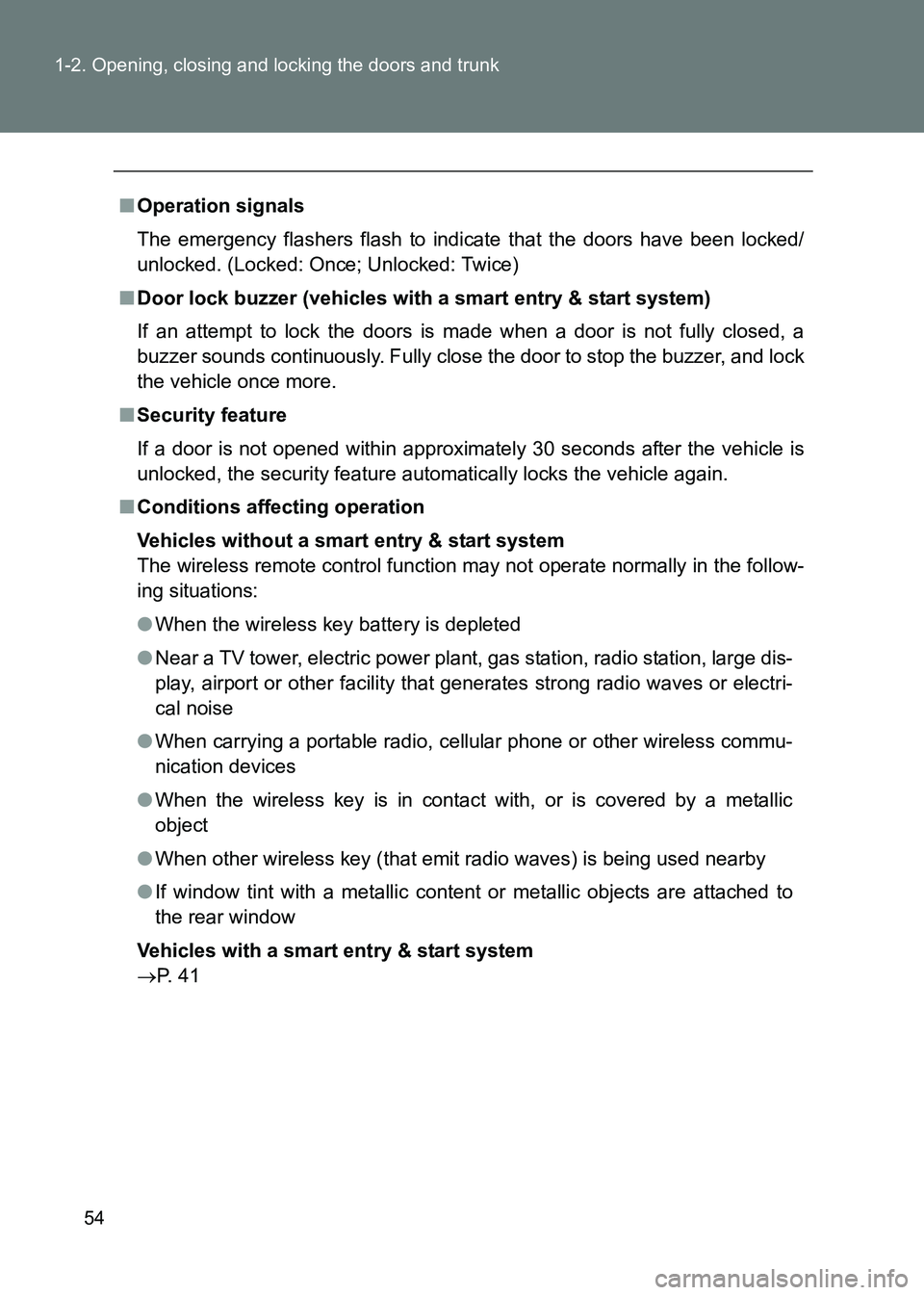
54
1-2. Opening, closing and locking the doors and trunk
86_EE (OM18071E)
■
Operation signals
The emergency flashers flash to indicate that the doors have been locked/
unlocked. (Locked: Once; Unlocked: Twice)
■ Door lock buzzer (vehicles with a smart entry & start system)
If an attempt to lock the doors is made when a door is not fully closed, a
buzzer sounds continuously. Fully close the door to stop the buzzer, and lock
the vehicle once more.
■ Security feature
If a door is not opened within approximately 30 seconds after the vehicle is
unlocked, the security feature automatically locks the vehicle again.
■ Conditions affecting operation
Vehicles without a smart entry & start system
The wireless remote control function may not operate normally in the follow-
ing situations:
●When the wireless key battery is depleted
● Near a TV tower, electric power plant, gas station, radio station, large dis-
play, airport or other facility that generates strong radio waves or electri-
cal noise
● When carrying a portable radio, cellular phone or other wireless commu-
nication devices
● When the wireless key is in contact with, or is covered by a metallic
object
● When other wireless key (that emit radio waves) is being used nearby
● If window tint with a metallic content or metallic objects are attached to
the rear window
Vehicles with a smart entry & start system
→ P. 4 1
Page 113 of 505
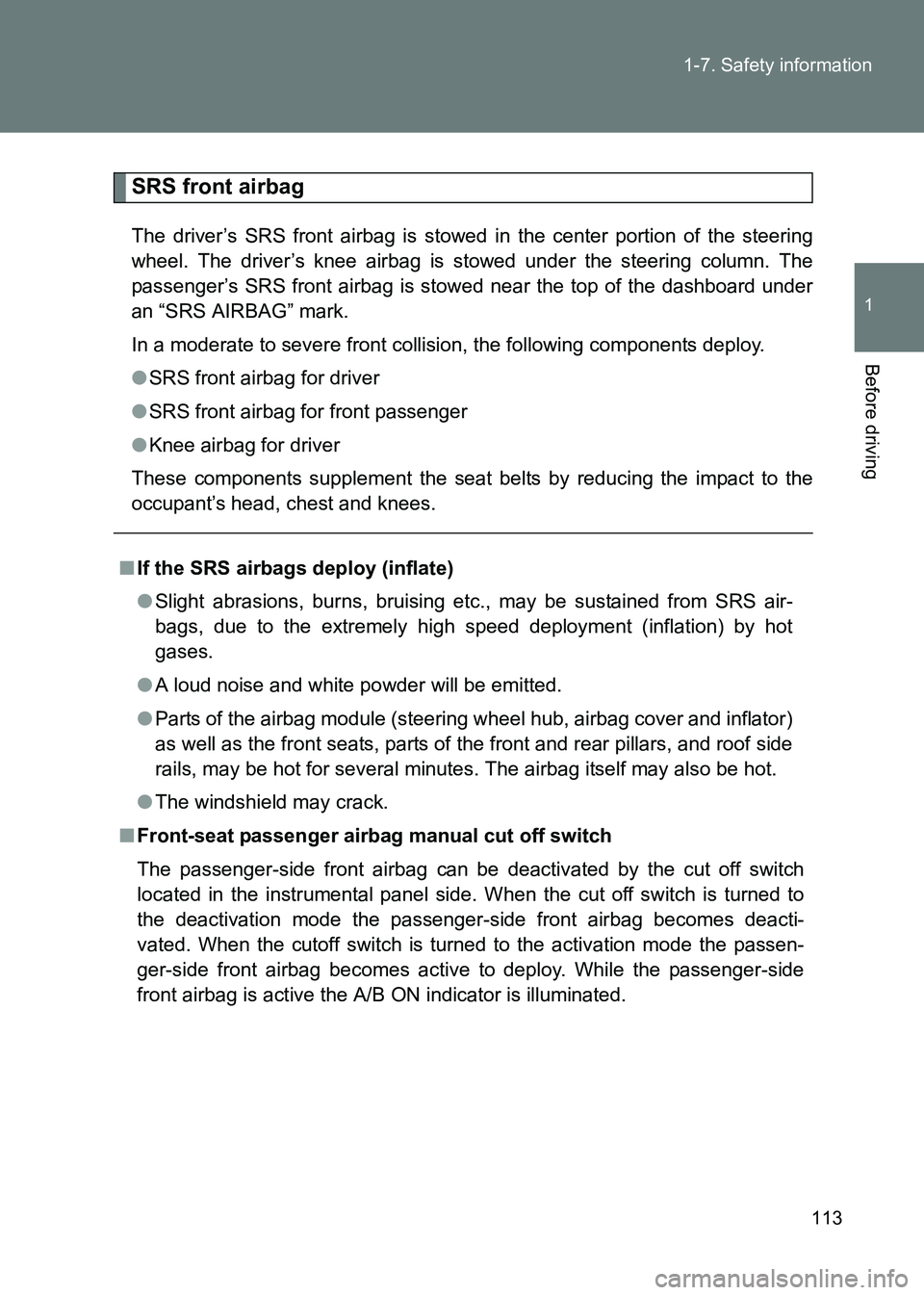
113
1-7. Safety information
1
Before driving
86_EE (OM18071E)
SRS front airbag
The driver’s SRS front ai
rbag is stowed in the cent er portion of the steering
wheel. The driver’s knee airbag is stowed under the steering column. The
passenger’s SRS front airbag is stowed near the top of the dashboard under
an “SRS AIRBAG” mark.
In a moderate to severe front collision, the following components deploy.
● SRS front airbag for driver
● SRS front airbag for front passenger
● Knee airbag for driver
These components supplement the seat belts by reducing the impact to the
occupant’s head, chest and knees.
■ If the SRS airbags deploy (inflate)
●Slight abrasions, burns, bruising etc., may be sustained from SRS air-
bags, due to the extremely high speed deployment (inflation) by hot
gases.
● A loud noise and white powder will be emitted.
● Parts of the airbag module (steering wheel hub, airbag cover and inflator)
as well as the front seats, parts of the front and rear pillars, and roof side
rails, may be hot for several minutes. The airbag itself may also be hot.
● The windshield may crack.
■ Front-seat passenger airbag manual cut off switch
The passenger-side front airbag can be deactivated by the cut off switch
located in the instrumental panel side. When the cut off switch is turned to
the deactivation mode the passenger-s ide front airbag becomes deacti-
vated. When the cutoff switch is turned to the activation mode the passen-
ger-side front airbag becomes active to deploy. While the passenger-side
front airbag is active the A/B ON indicator is illuminated.
Page 128 of 505
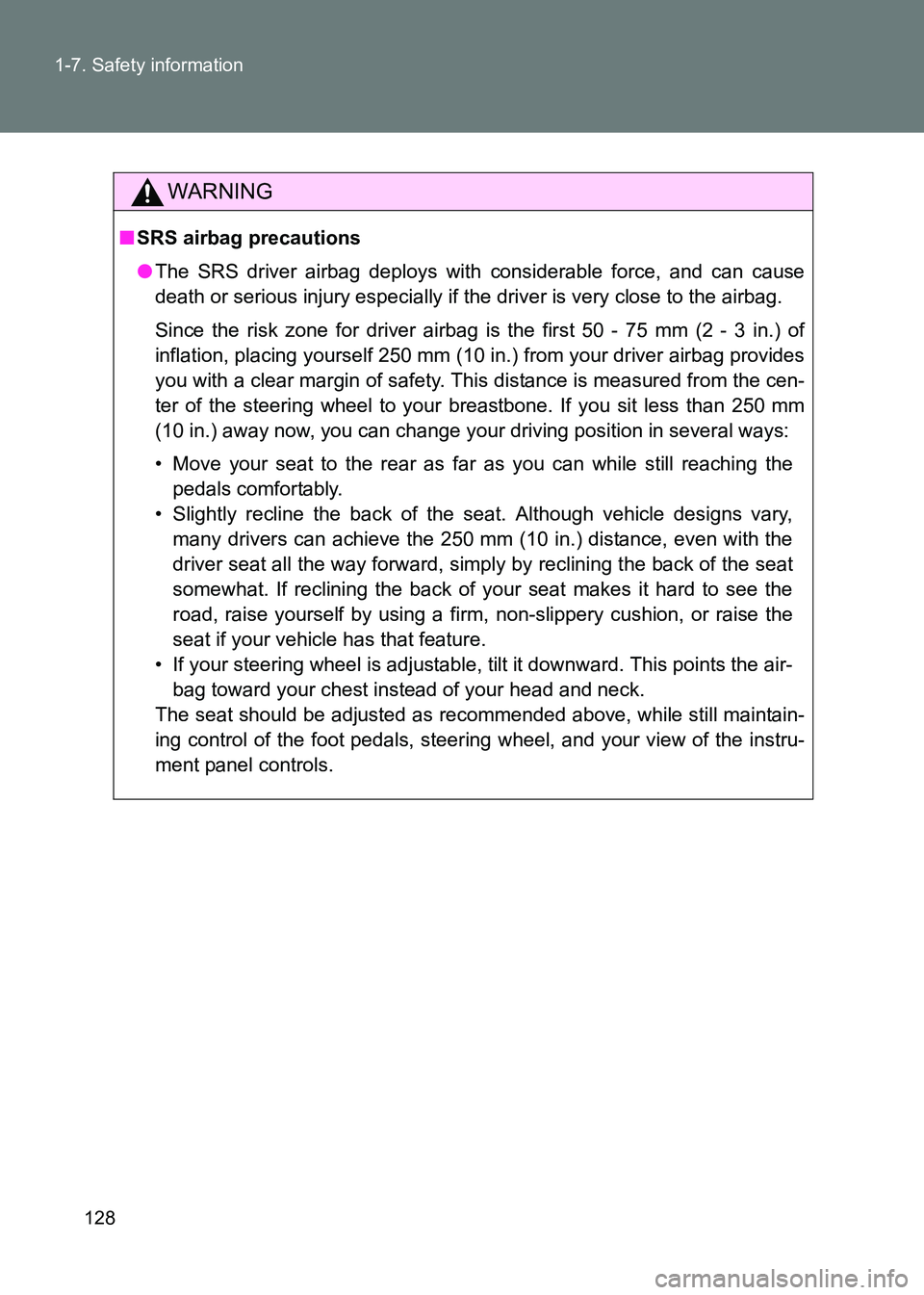
128
1-7. Safety information
86_EE (OM18071E)
WARNING
■
SRS airbag precautions
●The SRS driver airbag deploys with considerable force, and can cause
death or serious injury especially if the driver is very close to the airbag.
Since the risk zone for driver airbag is the first 50 - 75 mm (2 - 3 in.) of
inflation, placing yourself 250 mm (10 in .) from your driver airbag provides
you with a clear margin of safety. This distance is measured from the cen-
ter of the steering wheel to your breastbone. If you sit less than 250 mm
(10 in.) away now, you can change your driving position in several ways:
• Move your seat to the rear as far as you can while still reaching the pedals comfortably.
• Slightly recline the back of the seat. Although vehicle designs vary, many drivers can achieve the 250 mm (10 in.) distance, even with the
driver seat all the way forward, simply by reclining the back of the seat
somewhat. If reclining the back of your seat makes it hard to see the
road, raise yourself by using a firm , non-slippery cushion, or raise the
seat if your vehicle has that feature.
• If your steering wheel is adjustable, tilt it downward. This points the air- bag toward your chest instead of your head and neck.
The seat should be adjusted as recommended above, while still maintain-
ing control of the foot pedals, steering wheel, and your view of the instru-
ment panel controls.
Page 130 of 505
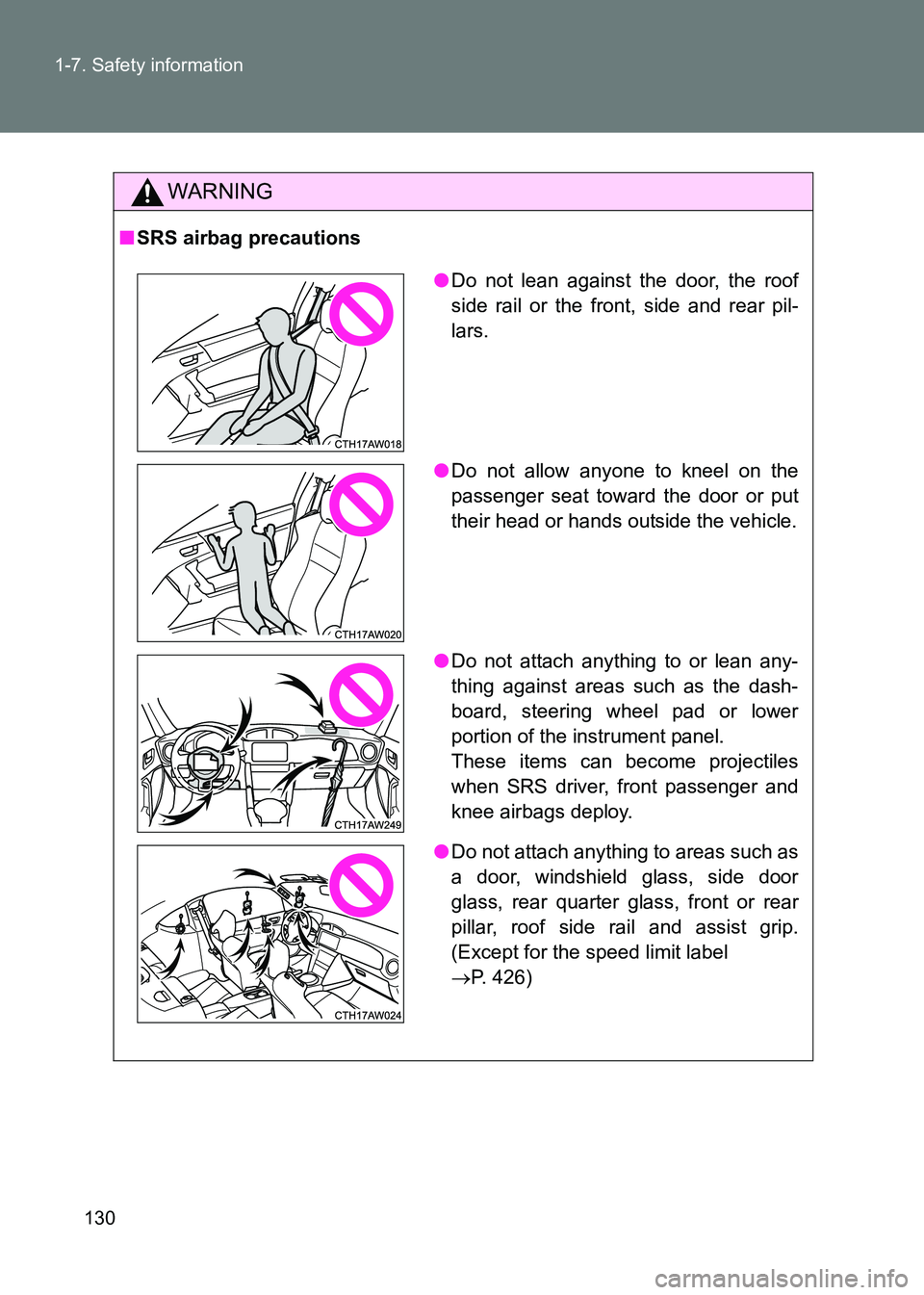
130
1-7. Safety information
86_EE (OM18071E)
WARNING
■
SRS airbag precautions
●Do not lean against the door, the roof
side rail or the front, side and rear pil-
lars.
● Do not allow anyone to kneel on the
passenger seat toward the door or put
their head or hands outside the vehicle.
● Do not attach anything to or lean any-
thing against areas such as the dash-
board, steering wheel pad or lower
portion of the instrument panel.
These items can become projectiles
when SRS driver, front passenger and
knee airbags deploy.
● Do not attach anything to areas such as
a door, windshield glass, side door
glass, rear quarter glass, front or rear
pillar, roof side rail and assist grip.
(Except for the speed limit label
→ P. 426)
Page 159 of 505
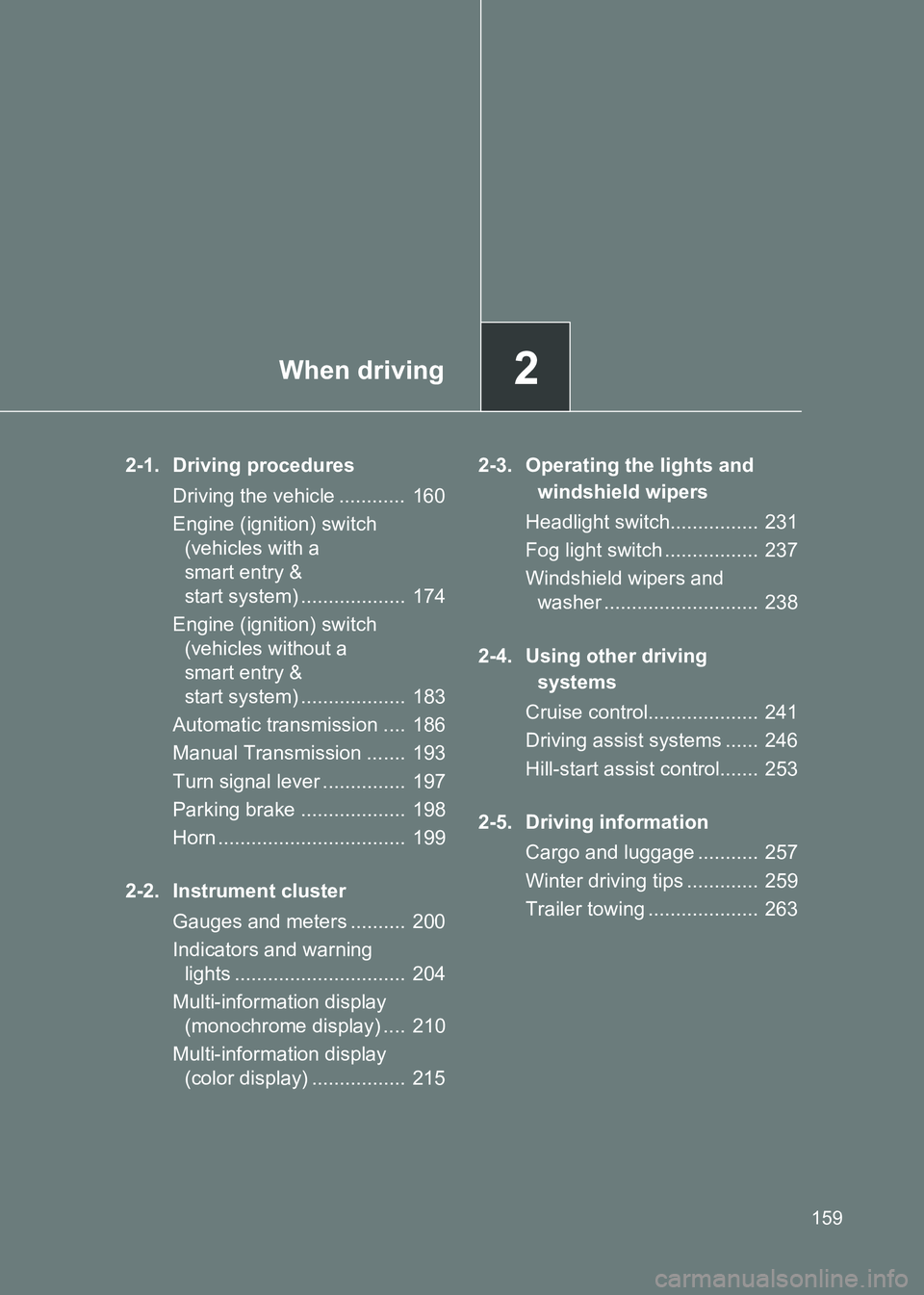
2When driving
159
86_EE (OM18071E)
2-1. Driving proceduresDriving the vehicle ............ 160
Engine (ignition) switch (vehicles with a
smart entry &
start system) ................... 174
Engine (ignition) switch (vehicles without a
smart entry &
start system) ................... 183
Automatic transmission .... 186
Manual Transmission ....... 193
Turn signal lever ............... 197
Parking brake ................... 198
Horn .................................. 199
2-2. Instrument cluster Gauges and meters .......... 200
Indicators and warning lights ............................... 204
Multi-information display (monochrome display) .... 210
Multi-information display (color display) ................. 215 2-3. Operating the lights and
windshield wipers
Headlight switch................ 231
Fog light switch ................. 237
Windshield wipers and washer ............................ 238
2-4. Using other driving systems
Cruise control.................... 241
Driving assist systems ...... 246
Hill-start assist control....... 253
2-5. Driving information Cargo and luggage ........... 257
Winter driving tips ............. 259
Trailer towing .................... 263
Page 232 of 505

232
2-3. Operating the lights and windshield wipers
86_EE (OM18071E)
Turning on the high beam headlights
With the headlights on, push
the lever forward to turn on the
high beams.
Pull the lever back to the center
position to turn the high beams
off.
Pull the lever toward you and
release it to flash the high
beams once.
You can flash the high beams
with the headlights on or off.